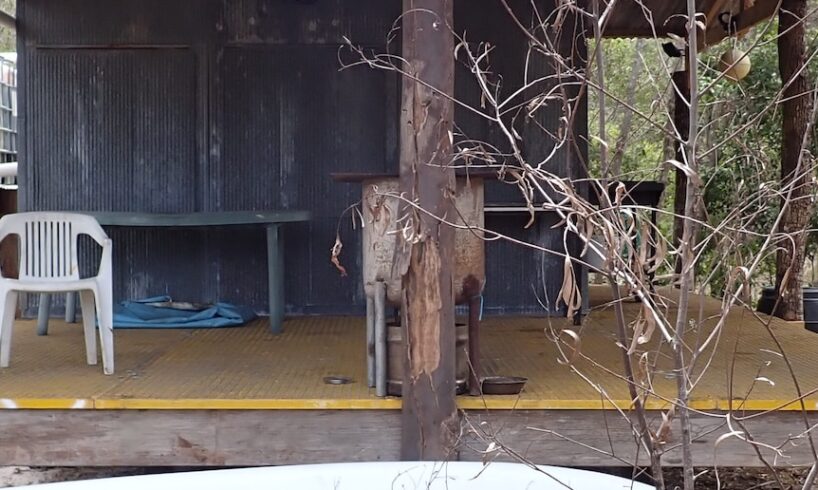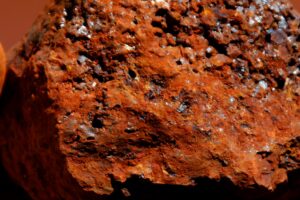
A group of 18 people have been fined thousands of dollars after an unauthorised cabin was built, partly with illegally harvested trees, in a national park on a central Queensland island.
Queensland’s Department of Environnment says the group holidayed regularly at the hut in a remote part of Curtis Island National Park over a period of months before they were detected.
The national park is on the east coast of Curtis Island, 16 kilometres from Gladstone, and is within the southern Great Barrier Reef, making it part of the World Heritage area.
Queensland Parks and Wildlife Service (QPWS) rangers noticed unusual activity in the park and carried out compliance patrols in the area, before uncovering the hut in August last year.
Surveillance footage of vehicles in restricted areas. (Supplied: Queensland Parks and Wildlife Service)
“It’s really disappointing that people have undertaken this activity,” said Tina Alderson, QPWS’s Great Barrier Reef and Marine Parks regional director.
“National parks are there for conservation and for the enjoyment of Queenslanders.”
Twenty-two fines, totalling $7,606, were handed to 18 people.
The illegal activity included driving offences in protected and restricted access areas. (Supplied: Queensland Parks and Wildlife Service)
Illegal activity
The cabin was complete with a barbecue area and verandah.
The Department of Environment says the group would drive to the cabin with guns, a boat, fishing equipment and pet dogs.
The illegal activity took part in a remote part of the national park. (Supplied: Queensland Parks and Wildlife Service)
Surveillance footage shows different vehicles towing dinghies and trailers, people standing on ute trays, all-terrain buggies, and motorbikes being driven in restricted areas.
Some of these vehicles were found to be unregistered.
The offenders were fined more than $7,000 for illegal activity in the national park. (Supplied: Queensland Parks and Wildlife Service)
Other illegal activities included lighting fires and bringing domestic dogs into a protected area, and hunting with guns.
The activities are illegal in protected areas under the Nature Conservation Act 1992 and Nature Conservation (Protected Area Management) Regulations 2024, as they put rangers, neighbours and park users at risk and impact the environment and native wildlife.
Trees cleared
Trees were illegally cleared and harvested to build parts of the hut.
Vehicles were captured on surveillance footage. (Supplied: Queensland Parks and Wildlife Service)
Ms Alderson said investigations were ongoing as to when the hut was constructed, but it appeared it was done over time and added to bit by bit.
“It’s hard to fully determine that,” she said.
“But certainly there are parts of the hut that were built fairly recently as some of the trees that have been used in part of the structure have only recently been cut down.”
“It’s a fairly remote section of the national park, and there’s only a few management tracks in that area, so it’s not highly visited.”
Trees were cut down to clear land to build the illegal hut, which will now be removed. (Supplied: Queensland Parks and Wildlife Service)
A seizure notice was published by the Department of Environment in January about the structure and for the owner to come forward.
It will be removed by rangers but they have been delayed by wet weather.
“Once the hut is removed, we’ll be able to have a good look at the site and see what works or rehabilitation or revegetation might need to be undertaken at the site,” Ms Alderson said.
Footage of motorbikes being ridden in restricted areas of Curtis Island National Park. (Supplied: Queensland Parks and Wildlife Service)
Home to endangered and threatened animals
Curtis Island is the third largest continental island in Queensland and is made up of sand dunes, beach ridges and salt flats.
Curtis Island, off the coast of Gladstone, is home to a diverse range of flora and fauna. (ABC Capricornia: Erin Semmler)
The park is home to the Capricorn yellow chat, a critically endangered bird.
Threatened flatback turtles also nest on the island’s beaches, along with migratory wanderers and other significant wetland species.
In 2023, the state government purchased a 1,500-hectare property, Spadely Station, on the north of the island for $12 million, with plans to look into ecotourism opportunities.





